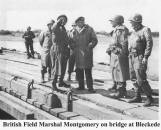| |
Bridge Over the Elbe River
It was late April, 1945. From the west, American,
British, and Canadian armies were closing in on the heart of a
collapsing Germany, with Russian troops crushing opposition from the
east. Berlin was slowly being battered into oblivion. Entire German
armies were surrendering to Anglo-American ground forces, and
fleeing the Russians in panic. Along the Western Front, a
three-pronged assault into Germany was led by two American army
groups and a British army group. To the north of the American
armies, British Field Marshal Bernard Montgomery's 21st Army Group,
consisting of the British 2nd Army and Canadian 1st Army, was
heading northeasterly from Munster towards Hamburg. Montgomery was
to protect the American 12th Army Group's left, and head towards the
Baltic Sea, starving the Germans out of Norway, and simultaneously
cutting off the Russians from Denmark. British General Sir Miles
Dempsey's Second Army spearheaded Montgomery's advance. The Canadian
1st Army, led by Lieutenant General Henry D. G. Crerar, was
northwest of the British Second Army, clearing Holland and
northwestern Germany, and providing safe ports at Wilhemshaven and
Bremerhaven on the North Sea. In the center, commanded by General
Omar N. Bradley's 12th Army Group, three American armies were
driving east, northeast, and southeast of Berlin. Each army advanced
with speed, racing across the German countryside, sometimes running
off their maps. Prior to the Rhine crossings, the average area
assigned to one group had been 12 by 18 miles. During the race to
the Elbe, areas were as large as 40 by 70 miles. (1)

Click for Large Picture
General overview of forces meeting in northern
Germany
The Ninth Army,
led by General William S. Simpson, led the northernmost American
corridor, with General Courtney Hodge's First Army moving south and
east of Ninth Army, from the rugged Harz Mountains. Lieutenant
General George S. Patton's Third Army had the southernmost corridor,
an assault through Frankfurt. Lieutenant General Jacob S. Dever's
6th U.S. Army Group had the objective of negating the so-called
"German National Redoubt", in the extreme south of Germany. The
British Second Army, had in fact, been working closely with the U.S.
Ninth Army since October, 1944. Both armies had cooperatively
exchanged information, discussed approaches, tactics, and logistics.
One of the underlying reasons for this partnership was due to the
lack of British equipment at this stage during the war. Many
American engineer troops and related equipment were actually used at
bridge sites contemplated and utilized for British army crossings.
Also, from October, 1944, until March, 1945, both the U.S. Ninth
Army, and Canadian First Army, had been under direct command of
British 21st Army Group. General Dwight D. Eisenhower, Commander of
Supreme Headquarters, Allied Expeditionary Force (SHAEF), had given
Field Marshal Montgomery the Ninth Army to insure success in the
north, following the Allied failure at Arnhem. In the west, the
geography of Germany was playing a major part in Allied planning.
Successful river crossings over the Rhine, Roer, and other waterways
were practical experience for the last objective-crossing the Elbe
River. This final phase of the central European campaign offered a
planned final opportunity to demonstrate Allied military tactics and
logistical superiority. For the most part, the geography, as well as
the weather, were favorable to all land-based objectives. U.S. Ninth
Army plans called for advances through hilly and heavily wooded
areas, into the industrial north. Several northern-flowing rivers,
as well as the numerous canals, presented serious considerations as
to the Ninth Army's route of advance. The larger cities, such as
Hanover and Bremen, were targeted as possible areas of organized
resistance. At this point in the war, Germany was barely able to
defend itself. The Allies had complete air superiority, and even if
the weather for air operations did not prove favorable, Germany
lacked the fuel necessary to move units around. Germany was low on
ammunition, medical supplies, and practically everything else. What
little industry Germany had left was isolated in the north, above
the Ruhr Valley. There was an ability to defend along a static
front, but Germany was not in a static situation. Tattered remnants
of Wehrmacht armies were disorganized, without coherent or
continuous communication from Berlin or each other. Military "units"
(Volksturm), consisting of 13-16 year old boys, as well as those men
50-65 years old, had been hastily raised and trained. General
Eisenhower had made one of the toughest decisions of his entire
military career in March, 1945, and one that was to have a post-war
impact of tremendous proportions, unknown at the time. The decision,
which proved to be equally unpopular and disheartening to many
American and British staff officers, was subsequently ignored by
many American ground forces. It was Eisenhower's decision that
Allied troops were to stop at the Elbe River, not proceeding
eastward - and the capture of Berlin.
Continued
 |
|